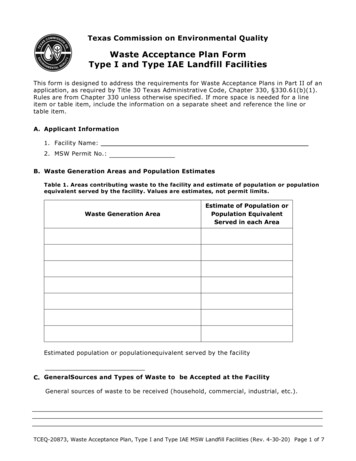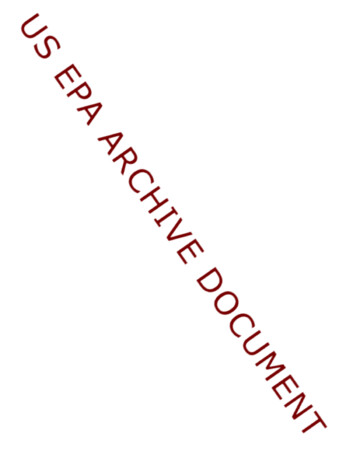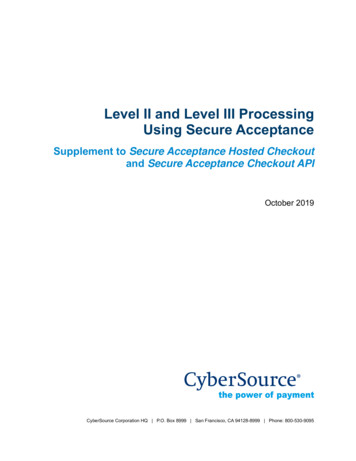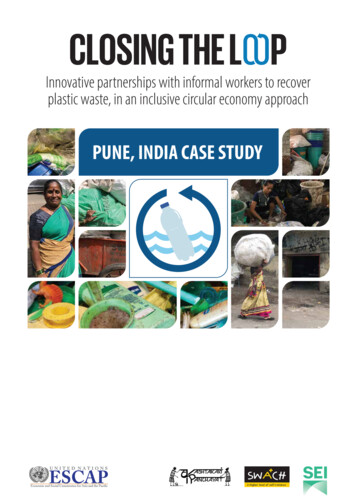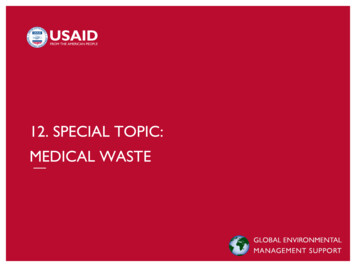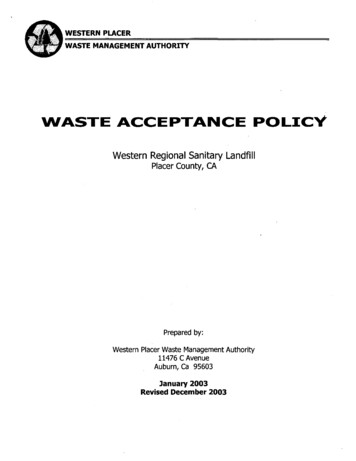
Transcription
WESTERN PLACERWASTE MANAGEMENT AUTHORITYWASTE ACCEPTANCE POLICYWestern Regional Sanitary LandfillPlacer County, CAPrepared by:Western Placer Waste Management Authority11476 C AvenueAuburn, Ca 95603January 2003Revised December 2003
TABLE OF CONTENTSPAGEIntroduction1Designated Wastes2Dewatered Treated Sludge2Septic Pond Sludge I Non-Treated Sewage Sludge2Soils3Railroad Ties I Treated Wood3Tires4Medical Wastes4Dead Animals4Other Special Wastes4Asbestos4Ash5Prohibited Wastes5APPENDICESAppendix AAppendix BAppendix CAppendix DAppendix ESolid Waste Facility PermitSample FormsThreshold Limit Concentrations for DeterminingHazardous Waste (CAM Wet Metals - Revised)Prohibited Wastes Posted at Landfill EntranceHousehold Hazardous Waste InformationWaste Acceptance Policy January 2003/Revised December 2003
INTRODUCTIONThe Western Regional Sanitary Landfill (WRSL) is located on Athens Avenue at theintersection of Fiddyment Road between the cities of Lincoln and Roseville. The landfill isowned and operated by the Western Placer Waste Management Authority (WPWMA).The WPWMA is a joint powers organization with members from Placer County, and thecities of Lincoln, Roseville and Rocklin. This policy defines the requirements for thedisposal of various wastes at the WRSL as provided in the Solid Waste Facility Permitwhich is attached to this Policy as Appendix A. The WRSL is currently permitted as Class II and Class Ill facility. Modules 5 through 9 and 14 through 16 are classified asClass II. The WRSL may accept designated wastes, in these modules. However, WRSLcurrently only accepts municipal solid waste and other special wastes not deemed to behazardous wastes or designated wastes. This Policy discusses the special wastes, whichthe WRSL will accept, and sets forth the conditions under which these special wastes maybe accepted. Wastes discussed in this Policy include: Designated WastesDewatered, Treated SludgeSeptic Pond Sludge/Non-Treated Sewage SludgeSoilsRailroad Ties/Treated WoodTiresMedical WastesDead AnimalsOther Special WastesAsbestosAshProhibited WastesBefore special wastes may be accepted at the WRSL, the Generator must providedocumentation showing that the waste meets minimum acceptance standards. Thisdocumentation shall include, but may not be limited to the following:Written Waste DescriptionThe Generator must provide a written description of the waste identifying the origin ofthe waste and providing sufficient information to assess the potential for the presenceof contamination. (Sample forms are attached as Appendix B.)Sampling and Analysis RequirementsLaboratory analysis may be required prior to acceptance of many special wastes.State-certified analytical laboratories must perform all analyses. Certified AnalyticalReports (CARs) and Chain of Custody Reports must be provided for all analyses.(Specific analysis and sampling requirements are described in detail for each specialwaste).Waste Acceptance Policy.January 2003/Revised December 20031
Note:The WRSL reserves the right to require Generators to providecertifications that wastes are not hazardous, and to deny permission to acceptsuch wastes until adequate certification is provided. For the purposes of thisPolicy, hazardous wastes include, but may not be limited to wastes listed andor included in the definitions contained in 40 CFR Part 261 or Title 22 of theCalifornia Code of Regulations.Designat:ed Wast:esDesignated wastes are not currently accepted at the WRSL. However, different conditionsin the future may result in the acceptance of designated wastes. At that point, theWPWMA will establish guidelines for acceptance criteria. Designated wastes will not bedischarged to Class Ill Modules.·Devvat:ered Treat:ed SludgeSludge's covered in this section include, but may not be limited to light industrial sludge,wastewater treatment plant sludge, wash rack sludge, water treatment plant sludge, etc.Generators that process dewatered sludge on a daily basis shall submit certificationsannually documenting that the sludge is not hazardous. More frequent submittals will berequired in the event of process changes or if onsite personnel note obvious changes inthe physical appearance of the materials, (i.e. excess moisture, etc.) Such certificationsshall identify the place of origin of the sludge, and shall include documentation that at aminimum the sampling and analysis criteria set forth below have been met:CAM WET MetalsSolids Content as percentageGenerators that process sludge for disposal at the WRSL on a less frequent basis mustsubmit certifications on a load by load basis.Sludge's accepted at the Class Ill modules must be shown to have a solids content foreach daily event of at least 20% or greater if primary sludge or at least 15% or greater ifsecondary sludge. Solids content by percentage will be required on a daily basis todocument that the sludge has been processed.Sept:ic Pond Sludge/Non-Treat:ed Sewage SludgeGenerators of septic pond sludge and non-treated sewage sludge shall submitcertifications each time they dispose of such sludge. Such certifications shall identify theplace of origin of the sludge, and shall include documentation that at a minimum thesampling and analysis criteria set forth below have been met:Waste Acceptance Policy January 2003/Revised December 20032
CAM WET MetalsSolids content by percentage for each 6 inch layer of crustSolids content must be 20% or greater. Acceptable levels for the CAM Wet Metals areattached as Appendix C.Sampling must be performed by the Generator for each pond or place of origin. Care mustbe taken to assure that no free water is present in the load, and that the solids content ofeach load is representative of the analytical results. In the event that the scalehouseattendant determines that free water is present in the load, the load shall be rejected.SoilsOnly clean soils are accepted at WRSL. In the event that the condition of soils to bedisposed of is questionable in the determination of the scalehouse attendant due to odors,color, etc., the scalehouse attendant may refuse to accept the load and request that theGenerator provide certification signed and stamped by either a civil engineer or geologistregistered in the State of California, certifying that soil is not a hazardous waste.Documentation of the analysis must accompany the certification to ascertain that the soil isnot hazardous.For the purposes of this Policy, hazardous wastes include, but may not be limited towastes listed and or included in the definitions contained in 40 CFR Part 261 or Title22 of the California Code of Regulations.Railroad Ties/Treated WoodsTelephone poles and railroad ties containing creosote may be accepted if accompanied bya letter from the generator certifying that they are at least 25 years old and a statementthat the ties are not a designated or hazardous waste (under the landfills Class Ill status)and includes analytical testing for pentachlorophenol and cresol at a minimum. For thepurposes of this Policy, hazardous wastes include, but may not be limited to wasteslisted and or included in the definitions contained in 40 CFR Part 261 or Title 22 ofthe California Code of Regulations. Railroad ties, which originated from or were storedin, any railroad yard will not be accepted for disposal at the WRSL. If the scalehouseattendant determines that the wood waste is not weathered and dry, the Generator may berequired to provide additional analysis to determine if the materials are acceptable. In thisevent, the Generator shall provide certification that the sampling and analysis criteria setforth below have been met: EPA 8015 Mod. for GasolineEPA 8015 Mod. for DieselEPA 8150 for HerbicidesEPA 8080 for PesticidesEPA 8270 for Semi-Volatile OrganicCAM WET for Arsenic, Chromium, Copper, and ZincWaste Acceptance Policy January 2003/Revised December 20033
For the purposes of this Policy, hazardous wastes include, but may not be limited towastes listed and or included in the definitions contained in 40 CFR Part 261 or Title22 of the California Code of Regulations.The WRSL reserves the right to refuse large loads of railroad ties due to hazardsassociated with handling such loads. Generators of large loads of railroad ties must notifyWRSL prior to disposal.TiresTires may be accepted at WRSL. However, tires must be cut into quarters at a minimum.Whole tires will be accepted at the Materials Recovery Facility (MRF).Medical WastesMedical Waste is not accepted at the WRSL. Autoclaved wastes are considered MunicipalSolid Waste (MSW) and will be accepted at the WRSL. The Generator will be required toprovide documentation that the medical wastes have been treated and are not hazardous.For the purposes of this Policy, hazardous wastes include, but may not be limited towastes listed and or included in the definitions contained in 40 CFR Part 261 or Title22 of the California Code of Regulations.DeadAni nalsThe WRSL does not accept dead animals. Small dead animals that are occasionallydisposed in the residential waste stream will remain commingled with the waste whenburied.Other Special WastesSpecial requests to dispose of large quantities of other non-hazardous and non-designatedwastes such as food wastes, diatomaceous earth, polyurethane, enviro-coke, etc., shall bereferred to the Placer County Department of Facility Services, Solid Waste ManagementDivision, on a case by case basis.AsbestosThe WRSL does not accept asbestos containing materials (ACM). Small quantities of nonfriable ACM that are occasionally disposed as part of franchise haulers residential loadswill remain commingled with the waste and buried. Non-friable ACM is not accepted fromself haulers.Waste Acceptance Policy January 2003/Revised December 20034
AshThe WRSL does not accept industrial ash or any ash from commercial or agriculturalGenerators. Residential fireplace ash hauled by authorized franchise haulers may beaccepted at WRSL. Residential self-haul fireplace ash may be accepted, however, if thescalehouse attendant determines that the ash contains any trash waste other than woodash, WRSL reserves the right to refuse to accept such ash on a case by case basis.Residential burn-barrel ash is not accepted at the WRSL.Prohibi ed Was esDesignated and hazardous wastes are not accepted at the WRSL. A List of prohibitedwastes is posted at the scalehouse, and is attached as Appendix D. HouseholdHazardous Waste (HHW) will be accepted from residential customers at the WesternPlacer Waste Management Authority's 0NPWMA) HHW facility located at the WPWMA'sMRF adjacent to the WRSL. The criteria for acceptance of HHW is attached asAppendix E.A Small Quantity Generator Disposal Program is available to businesses. For furtherinformation on this program, contact Nortech Waste at 916.645.5230, extension 1010.Waste Acceptance Policy January 2003/Revised December 20035
Solid Waste Facility PermitNo. 31-AA-0210Waste Acceptance Policy January 2003/Revised December 2003
acility Number:SOLID WASTE FACILITY PERMIT31-AA-02102. Name and Mailing Address of Operator:me and Street Address of Facility:3. N arne and Mailing Address of Owner:Western Placer Waste Management Authority(WPWMA)11476 C AvenueAuburn, CA 95603Western Regional Sanitary Landfill3195 Athens AvenueLincoln, CA 95648Western Placer Waste Management Authority(WPWMA)11476 C AvenueAuburn, CA 956034. Specifications:a. Permitted Operations:[gJ Solid Waste Disposal Site0Transfer/Processing Facility (MRF)0Composting Facility (Green Material)b. Permitted Hours of Operation:0Transformation Facility0Other:(Receipt of Refuse/Waste) Mon.- Sat. 7:00am-7:30pm; Sun. 8:00am-5:00pm(Ancillary Operations/Facility Operating Hours) Mon.-Sat.7:30pm-8:30pm; Sun.5:00pm-8:30pmc. Permitted Maximum Tonnage: 1:.:2::.:0:.::0c Tons per Day624d. Permitted Traffic Volume:Total vehicles entering sitee. Key Design Parameters (Detailed parameters are shown on . ite plans bearing EA and CIWMB validations):Permitted Area (in tingTransformation36,350,000Design Capacity (cubic yds)Max. Elevation (Ft. MSL)295Max. Depth (Ft. MSL)57Estimated Closure Year2052Upon a significant change in design or operation from that described herein, this permit is subject to revocation or suspension. The attachedpermit findings and conditions are integral parts of this permit and supersede the conditions of any previously issued solid waste facility permit.6. Enforcement Agency Name and Address:Placer County Department of Health and Human ServicesEnvironmental Health Services11454 B AvenueAuburn, CA 95603Approving Officer Signature8. CIWMB Concurrence Date:7. Date Received by CIWMB:SEP 2 3 2002rmit Issued Date:DEC : i 2 200210. Permit Review Due Date:DEC i 2 2007NOV 1 9 200211. Owner/Operator Transfer Date:N/APagelof4
acility Number:SOLID WASTE FACILITY PERMIT31-AA-02101-."ega! Description of Facility:The legal description of this facility is contained on page 2-3 of the Joint Technical Document, dated September 9, 2002.13. Findings:a.This permit is consistent with the Placer County Integrated Waste Maoagement Plan, which was approved by the CIWMB onNov. 16, 1998. The location of the facility is identified in the Countywide Siting Element, pursuant to Public Resources Code(PRC), Section SOOOI{a).Ib.This permit is consistent with the standards adopted by the CIWMB, pursuant to PRC 44010.c.The design and operation of the facility is consistent with the State Minimum Standards for Solid Waste Handling and Disposal asdetemrined by the enforcement agency, pursuant to PRC 44009.d.The CDF, Nevada-Yuba-Placer Ranger Unit, has detemrined that the facility is in conformance with applicable fire standards,pursuant to PRC, 44151.e.A Supplemental Final EIR was filed with the State Clearinghouse (SCH # 1999092093) and certified by the Western Placer WasteManagement Authority on 8-10-00. The SFEIR describes and supports the design and operation which will be authorized by theissuance of this permit. A Notice ofDetemrination was filed with the State Clearinghouse on 8-11-00.I . "Prohibitions:The permittee is prohibited from accepting the following wastes:Hazardous, radioactive, medical (as defined in Chapter 6.1, Division 20 of the Health and Safety Code), liquid, or other wastesrequiring special treattnent or handling, except as identified in the Joint Technical Document and approved amendments theretoand as approved by the enforcement agency and other federal, state, and local agencies.15. The following documents describe and/or restrict the operation of this facility:DateJoint Technical DocumentAmendmentsWaste Discharge RequirementsOrder No. 99-126 or as revised9-9-02N.A.9-17-99 or rev.DatePrelinrinary Closure and PostclosureMaintenance Plan included in JTD9-9-02Closure Financial Assurance Documentation9-21-012-15-02APCD Permit to Operate #PLWR-01-0112-14-01Operating Liability CertificationSFEIR (SCH #1999092093)8-10-00Conditional Use PermitFinal Closure/Postclosure Maintenance Plans8-9-96 asamendedContract Agreement - operator and contractoroperator8-013-21-011-.(oseville Wastewater Discharge Permit#8877951-1-00Page 2 of4
acility Number:SOLID WASTE FACILITY ----------- ------------------ .;elf Monitoring:The operator shall conduct monitoring as outlined below and shall maintain records of the monitoring results. Unless otherwise mandatedby regulation, upon request the owner/operator shall submit the results of self monitoring programs to the Enforcement Agency. Therecords shall be kept by the operator for a period as specified in regulation.ProgramReporting Frequencya.The types and quantities (in tons) of waste, including separated or commingledrecyclables, entering the facility per day.Quarterlyb.The nwnber and types of vehicles using the facility per day.Quarterlyc.Results of the hazardous waste load checking program, including the quantities andtypes of hazardous wastes, medical wastes or otherwise prohibited wastes found inthe waste stream and the disposition of these materials.Quarterlyd.Copies of all written complaints regarding this fucility and the operator's actionstaken to resolve these complaints.Quarterlye.Results of the landfill gas monitoring program.Quarterlyf.Employee training recordsQuarterlyPage 3 of4
acility Number:[SOLID WASTE FACILITY PERMIT31-AA-021017. Enforcement Agency (EA) Conditions:a.The operator shall comply with all State Minimum Standards for solid waste handling and disposal as specified in Title 27, CaliforniaCode of Regulations.b.The operator shall maintain a log of speciaVunusual occurrences. This log shall include, but is not limited to, fires, explosions, thedischarge and disposition of hazardous or unpermitted wastes, and significant injuries, accidents or property damage. Each log entryshall be accompanied by a summary of any actions taken by the operator to mitigate the occurrence. The log shall be available to site·personnel and the EA at all times.c.Additional information concerning the desigu and operation of the facility shall be furnished upon request and within the time framespecified by the EA.d.The maximum permitted daily tonnage for this facility is 1200 tons per day, and more than this amount shall not be received without arevision of this permit. (This limit pertains to all waste material that enters the facility).e.This pennit is subject to review by the EA and may be suspended, revoked, or revised at any time for sufficient cause.f.The EA reserves the right to suspend or modify waste receiving and handling operations when deemed necessary due to anemergency, a potential health hazard, or the creation of a public nuisaoce.g.Any change that would cause the desigu or operation of the facility not to conform to the terms and conditions of this permit isprohibited. Such a change may be considered a significant change, requiring a permit revision. In no case shall the operatorimplement any change without first submitting a written notice of the proposed change, in the form of an Rl.'I amendment, to the EA at·,ast !50 days in advance of the change.h.A copy of this permit shall be maintained at the facility.i.Tires stored on-site shall be stored in a mallller so as to not accumulate water/breed mosquitoes.j.At all times that no one is on-site the facility shall be secured.k.An attendant shall be present during all hours the facility is open to the public to insure proper unloading and screening of wastes atthe working face and mini transfer station , when in use.I.At least once a day, on all days the facility is in operation, roads approaching the facility as specified below shall be patrolled andlitter picked up and removed to an approved disposal facility:Industrial Blvd. one mile north of Athens Ave. and south of Athens Ave. to Placer Blvd.Athens Ave. from Industrial Blvd. to Fiddyment Rd.Fiddyment Rd. one mile north and one mile south of Athens Ave.m. The facility shall provide a suitable winter operating area prior to the 15th of October each year.Page 4 of 4
Sample FormsWaste Acceptance Policy January 2003/Revised December 2003
WESTERN PLACERWASTE MANAGEMENT AUTHORITYAPPLICATION TO HAUL SOIL TOWestern Regional Sanitary LandfillAttention: The Solid Waste Facility Permit for the Western Regional Sanitary Landfill (WRSL)prohibits the acceptance of contaminated soils. This application is intended to assist us indetermining if your soil can be accepted and under what conditions. .I Phone:Fax::Please FAX Completed Application to· Bill Zimmerman Fax No 916 645 5185Business Name:Address:City:Zip:ST:I Phone:Fax::Contact Name:PROJECT LOCATION:I Assessor'sParcel No.Address:Citv:I Acres:No. ofStateZip:What is the current use of the Project Site?What was the historic use of the Project Site?Are there any or have there ever been one or moreunderground storage tanks onsite?0 YES 0Has any hazardous material beenstored or dumped on this site?0 YES 0Have there been any pesticidesor herbicides applied onsite?Has any environmental assessmentbeen performed onsite?NONO0YES0NO0YES0NODescribe the project. What is the origin of the soil?Dates Soil willbe hauled:I Start Date:I Ending Date:Hours Soil will be Hauled:Is the Soil well graded from course to fine?Number of Loads oer Dav:0YES0NOProposed YardsiTons per Load:If material is rocky, does the maximum size of rock exceed 8 inches?0YESDescribe the Soil:Quantity:Type (Clay, Loam, Sand, etc.)Moisture Content:0NOConserving Resources and the Environment through Recovery and Recycling11476 C !\venue DeWitt Center Au bum, Califomia 95603 www WPWMA.com
APPLICATION TO HAUL SOIL TOWestern Regional Sanitary Landfill'.lllge 2Groundwater SamplingDAir Monitoring:Flagger:DDYESYESD NOD NOSoil Sampling:Phase 1 Assessment:DYESDD NOYESD NOWill the Contractor provide any of the following to facilitate acceptance of this soil?Grading equipmentYESto form stockpile:0 YES D NO Water Truck:D YESD NOID NOI certify that to my knowledge, this information is true and correct.Please PRINT your name::::--:------------------------ Date:-------SignaturePlease FAX Completed Application to:Bill Zimmerman Fax No. 916.645.5185Conserving Resources and the Environment through Recovery and Recycling1 1476 C Avenue DeWitt Center Auburn, California 95603 www.WPWMA.com
WESTERN PLACERWASTE MANAGEMENT AUTHORITYSPECIAL WASTESWestern Regional Sanitary LandfillAttention: The Solid Waste Facility Permit for the Western Regional Sanitary Landfill (WRSL)prohibits the acceptance of designated or hazardous wastes. This application is intended to assist usin determining if your special waste can be accepted and under what conditions.I.Please FAX Completed Application to· Bill Zimmerman Fax No 916 645 5185I Fax:Phone: ·Business Name:Address:City:Zip:State:I Fax::Phone:Contact Name:Origin of Waste:I Assessor'sParcel No.Address:City:I Acres:No. ofState:Zip:Describe the Waste and ijs origin:What is the current use of the site where the waste is generated?What was the historic use of the sije?Have there been any pesticidesor herbicides applied onsite?D YESHas any hazardous material beenstored or dumped on this site?D YESDates Waste willbe hauled:DNODNOI Start Date:Has any environmental assessmentbeen pertonned onsije?D YESI Endina Date:Estimated quantity of waste (tonnage or cubic yards):Does the waste require special handling?0 YES D NO (If YES please describe:)Does the waste have a high moisture content?0 YES 0 NO (If YES, what is the content?)Conserving Resources and the Environment through Recovery and Recycling11476 C Avenue DeWitt Center Aubum, Califomia 95603 W\Vw.WPWMA.comDNO
SPECIAL WASTESWestern Regional Sanitary Landfillpage2Sampling and Analysis RequirementsLaboratory analysis may be required prior to acceptance of many special wastes. State-certifiedanalytical laboratories must perform all analyses. Certified Analytical Reports (CARs) and Chain ofCustody reports must be provided for all analyses.Note: The Western Regional Sanitary Landfill reserves the right to require Generators to ;provide certifications that wastes are not hazardous, and to deny permission to acceptsuch wastes until adequate certification is provided. For the purposes of this Policy,hazardous wastes include, but may not be limited to wastes listed and or included in thedefinitions contained in 40 CFR Part 261 or Title 22 of the California Code of Regulations.I certify that to my knowledge, this information is true and correct.Please PRINT your name --------------------Date:-------SignaturePlease FAX Completed Application toBill ZimmermanFax # 916.645.5185Conserving Resources and the Environment through Recovery and Recycling11476 C A\'cnuc DeWitt CL:ntcr Auhum, CalifOmia 95603 www.WPWMA.corn
PPENDIX CThreshold Limit Concentrations forDetermining Hazardous Waste(CAM WET Metals- Revised)Waste Acceptance Policy January 2003/Revised December 2003
THRESHOLD LIMIT CONCENTRATIONS FORDETERMINING HAZARDOUS WASTE(CAM WET METALS)UnitHazardousLevel g/10.75Cadmiummg/11Chromium/Chromium Illmg/1560Chromium ermg/15Thalliummg/17Vanadiummg/124Zincmg/1250Test Method/ConstituentsCAM WET 17 - MetalsWaste Acceptance Policy January 2003/Revised December 2003
Prohibited Wastes Posted atLandfill EntranceWaste Acceptance Policy January 2003/Revised December 2003
PROHJ:BJ:TED WASTESPOSTED AT LANDFILL ENTRANCEFour signs posted inside of the entrance to the landfill are worded as follows:NOTICE: Waste Materials must be covered during transportation.Sign 2NO HAZARDOUS WASTE ACCEPTED AT THIS FACILITYHazardous Waste Include:Paints, Solvents, Pesticides, Acid and Caustic Solutions, Gasoline,Explosives, Photographic and Pool Chemicals, Compressed GasCylinders, Ink, Pharmaceuticals, Radioactive and Infectious WasteASK BEFORE YOU DUMPWESTERN REGIONAL SANITARY LANDFILLALL LOADS SUBJECT TO INSPECTION FORPROHIBITED WASTESWe Thank YouI Sign 3No Dead AnimalsI Sign4Speed Limit 15 mphWaste Acceptance Policy January 2003
LIST OF PROHIBITED WASTE (Cont.)Universal Waste (U-waste) Common BatteriesFluorescent tubes, bulbs and other mercury containing lampsThermostatsElectronic devices (CRTs, Televisions, VCRs, Radios, C ll phones . )Electrical switches and relaysPilot light sensorsMercury gaugesMercury added noveltiesMercury thermometersNon-empty aerosol cans containing hazardous materials
Universal Wastes to be Prohibited From DisposalQuestions and Answers on Requirements for Handling Universal Wastes*1. What has changed? Until February 8, 2006 households and some small businessesare allowed to put waste batteries, electronic devices, and fluorescent light bulbs in thetrash. Homeowners can also throw away mercury-containing thermostats until this date.After February 8, these items, called universal wastes, should not be placed in thetrash.2. What are universal wastes and why can't I put them in the trash? Universalwastes are hazardous wastes that are generated by several sectors of society, ratherthan a single industry or type of businesses. Hazardous wastes contain harmfulchemicals, which, if put in the trash may harm people or the environmentUniversal wastes include:Common Batteries- AA, AAA, C cells, D cells and button batteries (e.g. hearingaid batteries). These may contain a corrosive chemical that can cause burns aswell as toxic heavy metals like cadmium. (Automotive type batteries are notuniversal waste. When they become waste, they are regulated under a differentlaw.)Fluorescent Tubes and Bulbs and Other Mercury-Containing Lamps Fluorescent light tubes and bulbs, high intensity discharge (HID), metal halide,sodium, and neon bulbs. These lights contain mercury vapor that may bereleased to the environment when they are broken. Mercury is a toxic metal thatcan cause harm to people and animals including nerve damage and birth defects.If mercury is released into the environment it can contaminate the air we breatheand enter streams, rivers, and the ocean, where it can contaminate fish thatpeople eat.Thermostats - There is mercury inside the sealed glass "tilt switch" of the oldstyle thermostats (not the newer electronic kind)Electronic Devices such as: televisions and computer monitors, computers,printers, VCRs, cell phones, telephones, radios, and microwave ovens. Thesedevices often contain heavy metals like lead, cadmium, copper, and chromium.Electrical Switches and Relays typically contain about 3.5 grams of mercuryeach. Mercury switches can be found in some chest freezers, pre-1972 washingmachines, sump pumps, electric space heaters, clothes irons, silent lightswitches, automobile hood and trunk lights, and ABS brakes.Pilot Light Sensors - Mercury-containing switches are found in some gasappliances such as stoves, ovens, clothes dryers, water heaters, furnaces andspace heaters
Mercury Gauges - Some gauges, such as barometers, manometers, bloodpressure, and vacuum gauges contain mercury.Mercury Added Novelties - Examples include greeting cards that play musicwhen opened; athletic shoes (made before 1997) with flashing lights in soles;and mercury maze games.Mercury Thermometers - Mercury thermometers typically contain about a halfgram of mercury. Many health clinics, pharmacies and doctor's offices havethermometer exchange programs that will give you a new mercury-free feverthermometer in exchange for your old one.Non-Empty Aerosol Cans that Contain Hazardous Materials- Many productsin aerosol cans are toxic. And many aerosol cans contain flammables, likebutane, as propellants for products like paint. If your aerosol can is labeled withwords like TOXIC or FLAMMABLE don't put it in the trash unless it is completelyempty.3. What happens if I throw universal waste in the garbage? Like used motor oil andpaint, universal waste is a kind of hazardous waste. It is illegal to dispose of hazardouswaste in the garbage. In addition, by throwing universal waste in the garbage, you cancause additional hazards to your garbage handler. Eventually, chemicals in illegallydisposed hazardous waste can be released into the environment and contaminate ourair, water, and possibly the food we eat.4. If I can't throw this stuff in the trash how do I get rid of it? Many localgovernment agencies run programs that help households and small businesses recycleor properly dispose of their hazardous wastes. Additionally, some retailers will collectcertain universal wastes, such as batteries. For information on local collectionprograms, contact your municipal waste service provider or click here for the list ofHousehold Hazardous Waste Program Web links.You can also check http://www.earth911.org for a universal waste collection programnear you.5. How do I know if a particular electroni
Designated and hazardous wastes are not accepted at the WRSL. A List of prohibited wastes is posted at the scalehouse, and is attached as Appendix D. Household Hazardous Waste (HHW) will be accepted from residential customers at the Western Placer Waste Management Authority's 0NPWMA) HHW facility located at the WPWMA's MRF adjacent to the WRSL.

